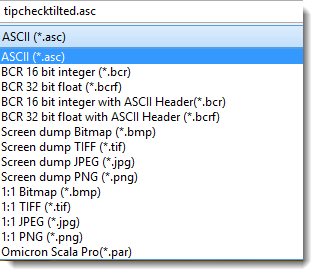
SPIP currently supports the following file output formats in which images and curve data can be saved:

|
*.asc |
ASCII file format for import in other programs; preserves physical dimension; applies to 2D image and curves including histogram |
|
*.bcr |
The BCR-STM file format , binary 16 bit integers; preserves physical dimension data; applies to 2D image and curves including histogram. |
|
*.bcrf |
The BCR-STM file format , binary 32 bit floating points; preserves physical dimension data; applies to 2D image and curves including histogram. |
|
*.bmp |
Bitmap, for import in most DT programs; applies to all data windows. The image will be saved as it appears on the screen but the raw data will be lost. |
|
JPEG for import in most DT programs; applies to all data windows. The image will be saved as it appears on the screen but the raw data will be lost. A high compression may be achieved but a small data distortion may occur. |
|
|
Tiff, for import in most DT programs; applies to all data windows. The image will be saved as it appears on the screen but the raw data will be lost. |
|
|
Png, for import in most DT programs; applies to all data windows. The image will be saved as it appears on the screen but the raw data will be lost. In this format void pixels will appear as transparent. |
|
|
1:1 .bmp, .tif, .jpg .png |
The 1:1 noted formats are used for image windows and will save the images with the same number of pixels as the source images independent from the size of the image window |
|
*.par |
Omicron Scala Pro format |
To save your images in other graphics file formats you can always Copy and Paste the windows content into third party programs.